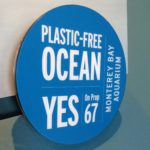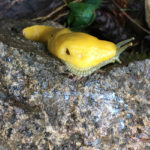
Olive ridley sea turtle hatchlings on the Osa Peninsula, Costa Rica. Photo by Sukee Bennett
I watched nearly 2,000 baby olive ridley sea turtles hatch while working on a sea turtle conservation project in Costa Rica. Most of them were born in our human-made hatchery from wild eggs we had relocated— each hatchling crawled and tumbled upon dozens of siblings in a sheltered plot, eager to be free. Others were born wild. They left miniature footprints in the sand and dodged vultures, coatis and crabs before we even spotted them. They all began life at about 20 grams, looking like animated chocolate treats and feeling like oven-baked clay in my hands. They scrambled into the sea with purpose and unyielding determination, just as they’ve done for millennia. Watching over them was surreal. And as the sun rose and the surf lifted them into its grasp, I’d forget they were just born.
The Pacific coast of Costa Rica, and the United States, is home to ridley, green, hawksbill, and leatherback sea turtles. But I’d never seen a juvenile of another species of turtle—the loggerhead—until September, when I saw a baby Atlantic loggerhead turtle bobbing like a miniature buoy at the Monterey Bay Aquarium. I was surprised to see it featured at an aquarium so far away from its native home.
Turns out, the tiny turtle is a part of a loggerhead rehabilitation and residence program run by the North Carolina Aquarium at Pine Knoll Shores. The Monterey Bay Aquarium has been a part of the program for three years, but because of future exhibit changes, this is its last. The aquarium’s turtle will be returned to North Carolina and released into the wild in a few short months.

Juvenile loggerhead turtle on exhibit in the open sea gallery at the Monterey Bay Aquarium. Credit: Monterey Bay Aquarium Newsroom
Loggerhead conservation affects far more organisms than the single species of turtle. Loggerheads migrate tens of thousands of miles in their lifetime; some travel 7,500 miles a year. During their journey, they use their sharp beaks to feed on mollusks and crustaceans. When they chew, the turtles break down the shells of their prey. This increases shell disintegration rates and the speed at which they get recycled into nutrients, scientists at Oceana, the largest international ocean conservation advocacy organization, say. And when loggerheads swim at the bottom of the sea, their moving flippers create whirls in the water, aerating the sand and the tiny organisms inside it. Loggerheads are ocean engineers, enabling other marine species to survive and flourish.
But these turtles are in trouble. They are notorious for swallowing objects they shouldn’t. When people dispose of plastics, they sometimes end up in the ocean. And when loggerheads eat, they accidentally ingest plastic debris. About 50 percent of marine plastic litter comes from urban sources, scientists say.
Jonelle Verdugo, curator and supervisor in Monterey Bay Aquarium’s husbandry department, explains because they don’t have fingers, turtles bite at things to figure out what they are. Across the country, Michele Lamping, an aquarist at the North Carolina Aquarium, finds that every loggerhead she necropsies has plastic in its gut.
Human impacts on loggerheads extend far beyond marine plastics. The juvenile loggerhead at Monterey and its North Carolina companions hail from tainted beaches. Beachgoers and their dogs accidentally or intentionally disturb nests. Urban development purges favorite nesting spots. Garbage and chemical runoff trickles down nesting beaches and into the water. Loggerhead hatchlings mistake streetlights for moonlight over the sea, and scramble away from the ocean and onto busy roads. Although many Atlantic states, like Florida, have light laws to protect baby turtles, there are none in North Carolina.
“We have extreme light pollution. We can turn on any light for as bright as we want, as long as we want. We’re losing hatchlings every time, with every nest that hatches. And it happens every year,” Lamping says.
But Lamping and participants in the North Carolina Aquarium loggerhead rehabilitation program are giving a second chance to an endangered species. Hatchlings that are healthy but struggling to make it to the sea are selected for their program, including those caught in a hurricane, dug up by foxes or dogs, or wandering the streets instead of swimming out to sea. Lamping says, “they’re perfect little awesome hatchlings” simply exposed to unfortunate circumstances.
It’s unlikely that rescued hatchlings would survive without human intervention. Because only one of 1,000 sea turtle hatchlings makes it to adulthood and loggerheads are endangered globally, North Carolina Aquarium’s program and its current participants—the Monterey Bay Aquarium and five others on the East Coast— are fundamental to loggerhead conservation and ocean health as a whole. “We got involved so we could display juvenile turtles and talk about the conservation message related to sea turtles, specifically loggerheads,” says Verdugo.

Carolina and Retread, two loggerheads at the New England Aquarium in Boston. Photo by Sukee Bennett
Program participants come together every autumn to release their one or two-year-old turtles in North Carolina. During the gathering, each aquarium receives a new two-month-old hatchling, which weighs about 60 grams— the same as a small kiwi—from the North Carolina Aquarium. The unnamed and unsexed 6.6-pound juvenile loggerhead now at Monterey was only 20 grams when it was rescued from North Carolina’s bustling shores in July 2015. Within two months, it tripled in size and flew from the Carolinas to California inside an Igloo cooler equipped with heating pads. Monterey Bay Aquarium staff monitored the animal’s temperature constantly; a subtle but fast drop in temperature can be fatal to cold-blooded reptiles.
Once in California, the baby loggerhead got acquainted to its new home—an unoccupied exhibit in the Aquarium’s Open Sea Gallery. Because loggerheads are notorious for their nibbling, the exhibit is sparsely decorated. The best sign that the loggerhead is staying healthy is it’s doing normal turtle activities, like swimming or bobbing around.
In the spring, the baby loggerhead and a few of its Monterey Bay Aquarium caretakers will fly back to North Carolina. The turtle will receive a passive integrative transponder (PIT) tag so scientists can keep track of it, and be released on the sandy shores. If it survives, it will join the ranks of adult loggerheads working as important ecosystem engineers.
But even while the juvenile loggerhead splashes around its exhibit in the Monterey Bay Aquarium, it’s making waves. “Sea turtles are a favorite animal to a lot of people, and when you see a baby sea turtle, it kind of grabs at the heart a little more,” says Verdugo.







Comments are closed.